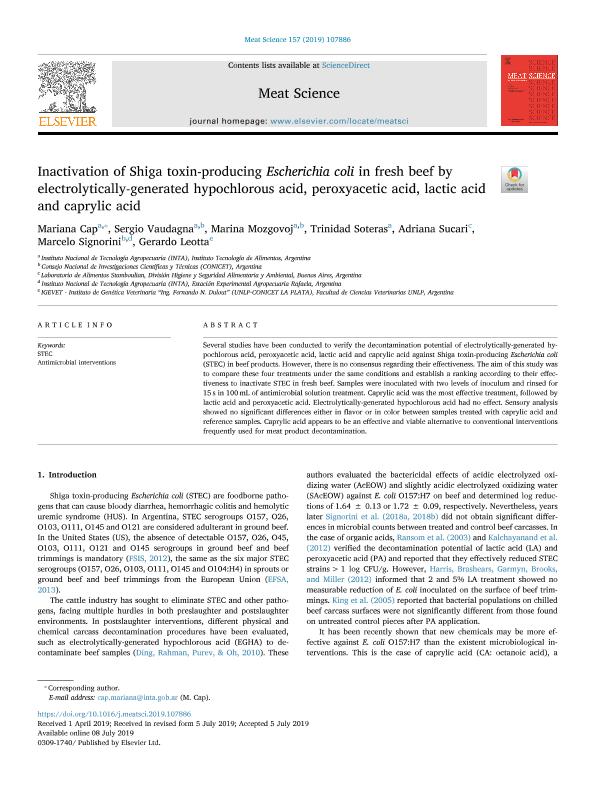Artículo
Inactivation of Shiga toxin-producing Escherichia coli in fresh beef by electrolytically-generated hypochlorous acid, peroxyacetic acid, lactic acid and caprylic acid
Cap, Mariana; Vaudagna, Sergio Ramon ; Mozgovoj, Marina Valeria
; Mozgovoj, Marina Valeria ; Soteras, Trinidad; Sucari, Adriana; Signorini, Marcelo; Leotta, Gerardo Anibal
; Soteras, Trinidad; Sucari, Adriana; Signorini, Marcelo; Leotta, Gerardo Anibal
 ; Mozgovoj, Marina Valeria
; Mozgovoj, Marina Valeria ; Soteras, Trinidad; Sucari, Adriana; Signorini, Marcelo; Leotta, Gerardo Anibal
; Soteras, Trinidad; Sucari, Adriana; Signorini, Marcelo; Leotta, Gerardo Anibal
Fecha de publicación:
11/2019
Editorial:
Elsevier
Revista:
Meat Science
ISSN:
0309-1740
Idioma:
Inglés
Tipo de recurso:
Artículo publicado
Clasificación temática:
Resumen
Several studies have been conducted to verify the decontamination potential of electrolytically-generated hypochlorous acid, peroxyacetic acid, lactic acid and caprylic acid against Shiga toxin-producing Escherichia coli (STEC) in beef products. However, there is no consensus regarding their effectiveness. The aim of this study was to compare these four treatments under the same conditions and establish a ranking according to their effectiveness to inactivate STEC in fresh beef. Samples were inoculated with two levels of inoculum and rinsed for 15 s in 100 mL of antimicrobial solution treatment. Caprylic acid was the most effective treatment, followed by lactic acid and peroxyacetic acid. Electrolytically-generated hypochlorous acid had no effect. Sensory analysis showed no significant differences either in flavor or in color between samples treated with caprylic acid and reference samples. Caprylic acid appears to be an effective and viable alternative to conventional interventions frequently used for meat product decontamination.
Palabras clave:
ANTIMICROBIAL INTERVENTIONS
,
STEC
Archivos asociados
Licencia
Identificadores
Colecciones
Articulos(CCT - SANTA FE)
Articulos de CTRO.CIENTIFICO TECNOL.CONICET - SANTA FE
Articulos de CTRO.CIENTIFICO TECNOL.CONICET - SANTA FE
Articulos(IGEVET)
Articulos de INST.DE GENETICA VET ING FERNANDO NOEL DULOUT
Articulos de INST.DE GENETICA VET ING FERNANDO NOEL DULOUT
Articulos(SEDE CENTRAL)
Articulos de SEDE CENTRAL
Articulos de SEDE CENTRAL
Citación
Cap, Mariana; Vaudagna, Sergio Ramon; Mozgovoj, Marina Valeria; Soteras, Trinidad; Sucari, Adriana; et al.; Inactivation of Shiga toxin-producing Escherichia coli in fresh beef by electrolytically-generated hypochlorous acid, peroxyacetic acid, lactic acid and caprylic acid; Elsevier; Meat Science; 157; 11-2019; 1-6; 107886
Compartir
Altmétricas



